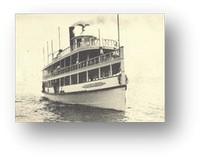Chautauqua County History
| Early History | Native American Tribes | Civil Rights |
The Early Years

Chautauqua County was created on March 11, 1808 by partition of Genesee County. Cattaraugus and Niagara Counties were also produced. On February 9, 1811, Chautauqua was completely organized, and so its separate government was launched. This established Chautauqua as a county of 1,100 Square Miles of land.
Chautauqua has not been altered since.
Part of the Eastern Continental Divide runs through Chautauqua County. The area that drains into the Conewango Creek (including Chautauqua Lake) eventually finds it's way to the Mississippi river, and empties into the Gulf of Mexico; the rest of the county's watershed empties into Lake Erie and out through the St. Lawrence seaway into the North Atlantic Ocean. This divide can be used to mark the border between the Southern Tier and the Niagara Frontier.
Chautauqua County is blessed with a lake that is about 26 miles long and 5 miles wide at it's widest part. Chautauqua lake has been a center for recreation and amusement since passenger railroad service connected the area with Pittsburg, Pa., Cleveland, Ohio, and Buffalo, Ny. in the 1860s. From Mayville, and Jamestown, visitors could travel by steamboat to points around the lake. During their heyday in the late nineteenth and early twentieth centuries, steamers provided transportation not only for pleasure seekers, but also for local residents. Daily trips between Mayville and Jamestown were made with stops at various places along the route. Steamers offered not only day excursions, but carried the mail and freight up and down the lake.

There were two amusement parks on the route. The earliest was at Celeron, on the lower lake, and the other at Midway, on the upper lake. Along with the steamboats, there were also trolley lines that ran on both sides of the lake. Often, families would ride the steamers up to Midway for a picnic, and then near the end of the day, would ride the trolleys home again, as it was faster.
In the early 1900s there were six large steamers on the lake, along with many smaller ones.
Chautauqua Now
Chautauqua is still a big tourist destination. Chautauqua Institute is known world wide.
Not only does it have a large boating community, the fishing is some of the finest in the world. The lakes favorite is the Muskellunge, a great fighting fish, and people come to Chautauqua from just about everywhere to fish for them.
Native American Tribes
In the early part of the seventeenth century, there was a tribe of Indians called by the French the Neutral nation, and by the neighboring tribes Kah-Khwas or Eries. Their territory lay along the northern shore of Lake Erie and the Niagara river, and eastward to the western limits of the Iroquois. Their domains extended west over Chautauqua county, and, it is believed, along the southern shore of Lake Erie, some distance into Ohio. They were eventually conquered by the Senecas.
Civil Rights and the Underground Railroad
In the early years, many runaway slaves came through the Chautauqua County region on their way to Canada.
The Underground RR had many stations around the area. Here a runaway could rest, get food and shelter, and sometimes hid from pursuers.
